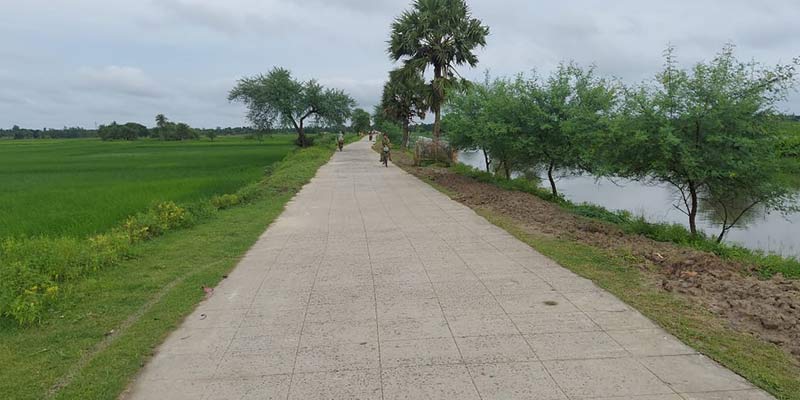- India
- Sep 12
Explainer - Pradhan Mantri Gram Sadak Yojana
• The Union Cabinet approved the implementation of the fourth phase of the Pradhan Mantri Gram Sadak Yojana (PMGSY-IV) for construction of 62,500 km of rural roads providing all-weather connectivity to 25,000 unconnected habitations.
• The Cabinet approved the proposal of the Department of Rural Development for implementation of the PMGSY-IV during financial years 2024-25 to 2028-29.
• The PMGSY-IV has been launched with a total outlay of Rs 70,125 crore, of which the central share is Rs 49,087.50 crore and the state share is Rs 21,037.50 crore.
Pradhan Mantri Gram Sadak Yojana
• Road connectivity is a key component of rural development by promoting access to economic and social services and thereby generating employment opportunities and increased agricultural income.
• It is also a key ingredient in ensuring sustainable poverty reduction.
• The unit for this programme is habitation and not revenue village or panchayat. A habitation is a cluster of population living in an area and the location of which does not change over time. Desam, dhanis, tolas, majras, hamlets, etc are commonly used terminology to describe habitation.
• It aims to provide rural connectivity, by way of a single all-weather road, to the eligible unconnected habitations of designated population size (500+ in plain areas and 250+ in northeast states, Himalayan States, desert and tribal areas as per 2001 Census) for uplifting the socio-economic condition of the rural population. In selected left wing extremism blocks, habitations of 100-plus population were also to be provided connectivity.
• Various independent impact evaluation studies carried out on PMGSY have concluded that the scheme has had a positive impact on agriculture, health, education, urbanization and employment generation, etc.
• Rural connectivity is a development imperative. All weather road connectivity to balance habitations would unlock the economic potential of the connected habitations. Upgradation of the existing rural roads would improve the overall efficiency of road network as a provider of transportation services for people, goods and services.
• The construction/upgradation of roads would generate both direct and indirect employment to the local populace.
• The PMGSY promotes use of new and green technology in construction of rural roads and locally available materials are used in road construction in order to promote cost-effective and fast construction.
• The PMGSY envisages a three tier quality assurance mechanism to ensure quality of road works during construction and post-construction. The number of quality monitors both at central and state levels as also the intensity of the inspections have been increased for better quality management.
Phases of PMGSY
• PMGSY-I was launched in December 2000 as a one-time special intervention to provide rural connectivity, by way of a single all-weather road, to the eligible unconnected habitations. The phase-I was a 100 per cent Centrally Sponsored Scheme.
• As the programme unfolded, a need was felt for consolidation of the existing rural road network to improve its efficiency not only as a provider of transportation services, but also as a vehicle of social and economic development. Accordingly, in the year 2013, PMGSY-II was launched for upgradation of selected through routes and major rural links with a target to upgrade 50,000 km in various states and Union Territories.
• Subsequently, in 2016, Road Connectivity Project for Left Wing Extremism Affected Areas (RCPLWEA) for construction/upgradation of strategically important roads was launched as a separate vertical under PMGSY.
• The phase-III of the scheme was launched in 2019. It involves consolidation of 1,25,000 km through routes and major rural links connecting habitations to Gramin Agricultural Markets (GrAMs), higher secondary schools and hospitals. It also includes maintenance of the roads constructed under the scheme.
Highlights of Phase IV
• Under the scheme, 62,500 km all-weather roads will be constructed for providing connectivity to 25,000 unconnected habitations and construction and upgradation of bridges on the new connectivity roads.
• The scheme covers habitations of population size of over 500 in plains and over 250 in northeast and Hill states, Union Territories and special category areas and over 100 in Left Wing Extremism (LWE)-affected districts according to Census 2011.
• The construction of required bridges along the alignment of the all-weather road will also be provided.
• The all-weather roads will play the role of catalysts for the required socio-economic development and transformation of the remote rural areas.
• While connecting habitations, the nearby government educational, health, market and growth centres will be connected, as far as feasible, with the all-weather roads for the benefit of the local people.
• New settlements have become eligible for the scheme due to population increase. The road construction will also generate 40 crore human days of employment.
• PMGSY-IV will incorporate international benchmarks and best practices under road constructions such as cold mix technology and waste plastic, panelled cement concrete, cell filled concrete, full depth reclamation, use of construction waste and other wastes such as fly ash and steel slag.
• PMGSY-IV road alignment planning will be undertaken through the PM Gati Shakti portal. The planning tool on PM Gati Shakti portal will also assist in detail project report (DPR) preparation.
Manorama Yearbook app is now available on Google Play Store and iOS App Store



